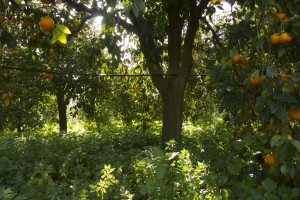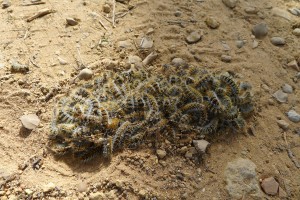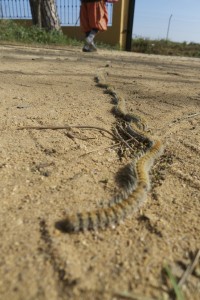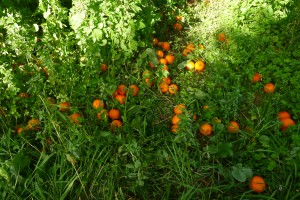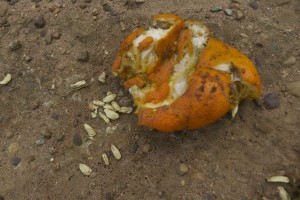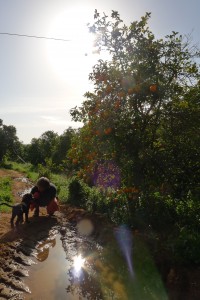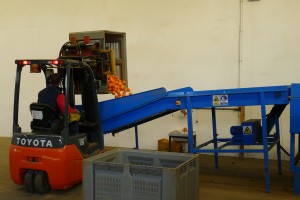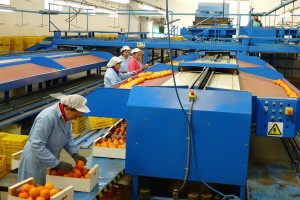Ave Maria
It’s getting close to the time when I will fly from Malaga to Berlin, to teach for a week at the TangoLab in Proitze. So after my Tango workshop in Huelva on Tuesday night, we drive on to just beyond Sevilla, where we stop for what’s left of the night. The next morning, we are in search of Ave Maria, the Organic Orange farm that supplies the Fruit Bowl, Frank’s local grocer in Cardiff, with organic Seville Oranges, which Frank always uses to make his marmalade. But first we take a stroll through the little town, to buy some bread and enquire about the location of the farm.
The vernacular is so different from the blue-white houses of Portugal. Everything seems a lot grander, and all the windows have heavy, wrought-iron bars on them, on all floors, and there are pillars to protect the tops of the roofs. Bulls could safely run through this town without being able to break any windows, that’s for sure. We wonder what the need for such security is, when not far away in Portugal, the houses don’t have any fortification at all. I see a woman behind bars cleaning the open window, so I cross the road to ask her this question. Before I can even open my mouth, she turns me away, making a fly-swatting gesture with her hand. For a second, it works and I stay on the other side of the road. But then I don’t want her to get away with this; it seems such a prejudiced gesture. So I cross again, gently speaking to her, saying in my best Spanish that I didn’t want to sell her anything, just wanted to ask a question. She grudgingly allows me a question, so I ask why the bars, what’s the need for such security. She looks at me as if I was stupid and says so that thieves can’t get in. I ask if there was such a high criminality here in Spain, compared to Portugal where the houses had unfettered windows. She is a bit non-plussed and can’t really answer this, other than saying that there is no criminality in this town.
She remains very uncomfortable with me talking to her, despite the fact that I am several meters away from her and that there is a set of iron bars between us. I didn’t know I was so dangerous! Maybe I look a bit like a Gypsy, and judging by the defensive stance of the Gypsies we met some weeks ago, there seems to be an entrenched hatred of travelling folk amongst the Spanish…
It’s still early in the morning and the tourist information point isn’t really open yet, but nevertheless, three helpful women give us plenty of information, researching the whereabouts of the organic farm online and plying us with several maps to find them, as well as pointing out a bakery which, according to them, has fantastic bread. It turns out it’s the cardboard variety, but has been baked in a wood fired oven… I eat far too much of it in one go, and I pay for it with a hammering headache the following day. I should know better, but there we go, sometimes we have to be painfully reminded of what’s good for us and what isn’t.
We find the farm and receive a very friendly welcome from Amadora who runs the farm. Having driven through miles and miles of mono-cultured orange groves that have absolutely nothing growing under the trees, seeing the groves of Ave Maria is pure delight. Happy trees with happy undergrowth, and the air is humming with insects and twittering with birds.
We see some pretty serious caterpillar action too – they have fallen off a pine tree in a heap, pulsating rhythmically until they work out which way they want to go, at which point, they march off in single file!
Amadora invites us to feel at home on the farm and to go and explore the orange groves. We find out that the rejects from the sorting belt go back underneath the trees to return the nutrients to the earth.
We see some oranges that obviously have been pecked, not for their flesh but for their pips:
Two lovely Labrador puppies follow us on our way through the farm
We bring a jar of marmalade and a jar of medlar jam to Amadora, who reciprocates with a jar of their marmalade and a booklet about their farm. When we open the booklet we find a very moving letter from her mother to English marmalade makers, expressing her gratitude for the continued interest the English have for bitter oranges, which enable her family to live in this place and put their passion into growing the very best Seville oranges.
This farm delivers to many places in the UK, amongst them Waitrose and Riverford Farm!
So if you’ve had an orange in your Riverford veggie-box this week, we may have seen it rolling along the conveyor belt, plopping into the hands of one of the six hardworking women who select the best and return the rest to the trees. Imagine we’ve snuck a little sticker on it, saying, hello Wendy, hello Emily, Natalie, Max, Leah, Mel, Leo, Rolf and Maria, hello unborn child. We love you, we miss you, we send you sunny greetings from the south of Spain!
****
Here is Ave Maria’s web site
Posted in Uncategorizedwith comments disabled.
Culatra Island
When looking for the library in Olhaõ, Frank asked someone in his best Portuguese for directions, to get the answer I don’t know, mate, I don’t live here I only work here. This is how we met Captain Steve. As his name says, he loves the sea and has made it his business to show the beauty of the sea and landscape to foreign visitors, be it by boat, kayak, cycling trips or tours with the minibus into the interior.
Steve’s boat ‘Seta’ is a traditional wooden Portuguese boat, and a joy to travel in. We go on a trip to Culatra Island with him, where the traditional fishing village seems to have stopped development about 40 years ago. One can only buy a house on Culatra if one is involved with the marine industry, so there are no concessions to tourists here. No hotels, no holiday homes. The island has no cars, and after a hearty lunch with freshly grilled fish, we take a stroll in the sun, along the sandy paths that run between the fisherman’s houses. There is a really special atmosphere here – the absence of cars, the dryness (it only rains 4 days in the year here, according to the captain), the sandy roads, and everywhere there are people. It’s a busy village. The 4pm ferry spills out a few dozen teenagers on their way back home from school on the main land.
Steve knows many of the islanders, and they give him a friendly welcome wherever he goes in the village, which allows him to show us places that we would otherwise not have found ourselves.
He takes particular delight in showing us a washing line full of drying fish and introducing us to 92 year-old Maria, one of the oldest inhabitants of the island.
From spring onwards, Steve says, this trip offers a lot more in terms of marine wildlife and other fauna and flora, and trips start to include swimming and snorkeling in the crystal-clear waters of the lagoon, set as it is within the National Park of the Ria Formosa.
Around 4pm, we get back on his boat and putter back to Olhaõ, having had a fantastic, international day with a small group of French, Dutch and English tourists, made all the richer by Captain Steve’s informative and entertaining stories as we went along.
*****
There is a nice set of photos about the island here
Link to Captain Steve’s web site ktalgarve.com
Posted in Uncategorizedwith comments disabled.
